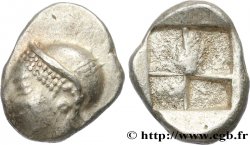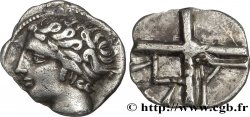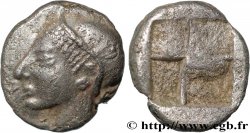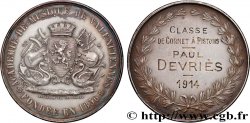Live auction - bga_1034764 - MASSALIA - MARSEILLE Hémiobole à la tête de satyre et à la corne
You must signin and be an approved bidder to bid, LOGIN TO BID. Accounts are subject to approval and the approval process takes place within 48 hours. Do not wait until the day a sale closes to register. Clicking on "BID" constitutes acceptance of the terms of use of cgb.fr private live auctions.
Bids must be placed in whole Euro amounts only. The sale will start closing at the time stated on the item description; any bids received at the site after the closing time will not be executed. Transmission times may vary and bids could be rejected if you wait until the last second. For further information check the Live auction FAQ
All winning bids are subject to a 18% buyer’s fee.
All winning bids are subject to a 18% buyer’s fee.
| Starting price : | 150 € |
| Estimate : | 300 € |
| Price : | 521 € |
| Maximum bid : | 521 € |
| End of the sale : | 22 July 2025 16:02:59 |
| bidders : | 2 bidders |
Type : Hémiobole à la tête de satyre et à la corne
Date: 410-336 BC.
Metal : silver
Diameter : 7 mm
Weight : 0,15 g.
Rarity : R3
Coments on the condition:
Très belle obole quasi SUP, frappé sur flan court et ovale, bien centré. Patine grise aux légers reflets bleutés
Catalogue references :
Obverse
Obverse legend : ANÉPIGRAPHE.
Obverse description : Tête masculine à droite.
Reverse
Reverse legend : ANÉPIGRAPHE.
Reverse description : Une sorte du virgule.
Commentary
Bien que ce type de monnaie est habituellement datée autour de 60-40 avant J.C. et attribué aux Salyens, on propose une datation bien plus ancienne (150 à 100 avant J.C.) dans le Dictionnaire des monnaies découvertes en Gaule méditerranéenne de Michel Feugère et Michel Py (2011). Maurel (2018), quant à lui, les place plutôt dans les périodes préclassique et classique de Massalia.
Although this type of coin is usually dated around 60-40 BC and attributed to the Salyens, a much older dating (150 to 100 BC) is proposed in the Dictionnaire des monnaies découvertes en Gaule méditerranéenne by Michel Feugère and Michel Py (2011). Maurel (2018), for his part, places them rather in the preclassical and classical periods of Massalia.
Although this type of coin is usually dated around 60-40 BC and attributed to the Salyens, a much older dating (150 to 100 BC) is proposed in the Dictionnaire des monnaies découvertes en Gaule méditerranéenne by Michel Feugère and Michel Py (2011). Maurel (2018), for his part, places them rather in the preclassical and classical periods of Massalia.








 Report a mistake
Report a mistake Print the page
Print the page Share my selection
Share my selection Ask a question
Ask a question Consign / sell
Consign / sell
 Full data
Full data












